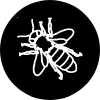Safety
Our earth is everything we have. This is why we want to keep the influence of modern crop protection on nature as low as possible. Find out about the science and actions behind the safe handling of crop protection products.
To be able to ensure environmental safety, we first need to understand what the potential risks are. Do you know what the difference between a hazard and risk is?
A shark in the water is a strong hazard. But if standing safely ashore, there is no exposure to the hazard – as a result, there is no risk. If standing in the water, you're directly exposed to the hazard – accordingly, there is a risk.
So, what does that mean in the context of environmental safety?
To understand the potential risk of using a specific crop protection product, we need to understand the intrinsic hazard of a substance for a wide range of organisms, from bees to fish to birds – and we need to know what the potential exposure levels of these organisms in the environment could be.

Effect Level Testing
Toxicity to different species is tested.
 | Birds & Mammals Acute (mortality) and chronic (reproduction) effects on birds and mammals from exposure to residues in feed items. |
 | Non-Target Anthropods Effects on survival and reproduction for arthropods like beetles, spiders and mites – both in the field and in field margins. |
 | Soil organisms Acute and chronic effects on earthworms, soil macro-organisms (e.g. soil mites) and micro-organisms (bacteria). |
 | Aquatic organisms Acute and chronic effects on all levels of aquatic food chain/web – algae, plants, invertebrates and fish. |
 | Bees Mortality of individuals after oral and contact exposure for honeybees and - if required - other bee species. |
 | Non-target plants Effects on seeds and young plants outside of the cropped field. |
Exposure Level Testing
Laboratory and field experiments as well as model calculations and real-world monitoring programs are used to investigate and understand the distribution of substances between the different environmental compartments (soil, groundwater, surface water, air), how they degrade and which metabolites they form. All identified metabolites are investigated in the same way to understand their environmental behavior, too.
 | Ground Water |
 | Surface Water |
 | Soil |
Combining the results from effect and exposure levels testing, we can quantify the environmental risk.
To get all this information, we evaluate and test in several areas.
Ecotox
The science of ecotoxicology has evolved over the past 50 years and — as indicated by the name — combines knowledge and techniques from both ecology and toxicology.
How toxic is the compound to the non-target organisms?
Testing on mites, beetles, parasitic wasps and sometimes spiders. Measured toxicity values are LR50 and ER50. Usually, the product is tested.
Testing on different plant species representative for different taxonomic groups, including monocotyledonous and dicotyledonous plant species (e.g. beet, sunflower, tomato, ryegrass etc.). Usually, the product is tested.
Testing on earthworms, soil mites, springtails and soil microorganisms. Usually, the active substance, the product and major metabolites are tested.
Acute and chronic testing on adult honeybees and if needed, additional testing on bumblebees and honeybee larvae.
Testing for effects of acute and chronic exposure to a substance on mice, rats and/or rabbits. Many tests on rats, mice, etc. are conducted to investigate and describe the effects of a substance in humans (human toxicity). Some of these results are also useful for understanding potential effects on wild mammals and the data relevant to the area of ecotoxicology. As a result, we can reuse the toxicity data for ecotoxicology questions – this means that we only test vertebrates once.
Testing for the effects of both acute and chronic exposure to a substance on fish, aquatic invertebrates (e.g. water fleas), sediment organisms, algae and aquatic plants. Usually, the active substance, the product and relevant metabolites in water and/or sediment are tested.
Testing for effects of acute and chronic exposure to a substance on quails, mallards and sometimes canaries.
Testing the potential impact of a crop protection product on non-target organisms is very important, as one of our key goals is to protect the organisms that are not targeted by the crop protection product.
Environmental Fate
To be able to quantify the exposure of all the organisms we do not want to harm, we need to understand what happens to a substance when it is released in the environment.
Degradation in the soil by microorganisms and on the soil surface by sunlight: how long does it take until a substance is degraded, and which metabolites are formed in which amounts? Studies are conducted in the laboratory under standardized conditions, as well as in the field under natural conditions and close to agricultural practice. These studies provide the degradation half-life of a substance and its degradation pathway in soil. Adsorption and desorption studies describe the binding of a compound to the soil. These studies are conducted in the laboratory under standardized conditions to determine the immobility or mobility of a compound in the environment.
The volatility of a substance is determined to check its potential to evaporate into the air. If that might happen, the subsequent degradation of the substance in the air is calculated with a validated model that simulates the breakdown of the substance by reactive molecules (e.g. hydroxyl radicals) that are naturally produced by sunlight. A compound with a half-life shorter than 2 days will not travel in the air over longer distances.
How likely is it that an active substance or its metabolites can reach groundwater, and which concentrations should be expected? We answer this question with model calculations, experimental studies and monitoring data. With established and validated scientific models we simulate the transport of the compounds in soil (see the “Exposure Modelling” section). Studies with intact soil cores, as well as different studies under field conditions can confirm and refine the model predictions. Field observations from so-called monitoring studies allow a definitive check of the leaching risk under real-world conditions. The concentrations of a pesticidal active substance in groundwater (at 1m depth beneath a treated field as a worst-case) must be lower than 0.1 μg/L, otherwise, the use of the product is not allowed in the EU.
Degradation and distribution in surface water bodies: how long does it take until a substance is degraded in surface water, and which metabolites are formed in which amounts – both in water and in the sediment? Studies are conducted in the laboratory, with water and sediment sampled from natural ponds or streams. This information is used to generate the degradation or dissipation half-lives of a substance and a degradation pathway in water-sediment systems, both from microbial degradation and the impact of sunlight.
Exposure Modelling
Based on our understanding of the environmental fate, (the degradation, metabolism and mobility), of the compound, and its use pattern, we can predict the concentrations that must be expected in the different environmental compartments when the compound is applied by the farmer. These so-called PEC values (Predicted Environmental Concentrations) are calculated with established and validated scientific models that are approved by regulatory authorities.
The model calculations use a range of soil and weather conditions that are representative for agricultural areas across Europe, combined with information on application regime, application rate, application timing, number of applications, and the crop to which a product will be applied. This allows us to predict concentrations of the active substance and its metabolites:
- in soil after the compound is applied on the field
- in water and sediment after exposure via spray drift, drainage or run-off.
- in groundwater after leaching through the soil
The model parameters are set so that realistic worst-case concentrations are calculated, which will generally not be exceeded under real-world conditions.
If the predicted concentrations show a potential risk, mitigation measures are mandatory to reduce the exposure. In such a case, the models are used to predict the reduction of exposure for a refined risk assessment. You can learn more about mitigation further down in the scroll-story.
Environmental Safety Assessment
Based on the knowledge about ecotoxicology, environmental fate, and environmental exposure, we conduct an environmental safety assessment:
Do the expected concentrations in the environment pose an unacceptable risk to non-target organisms?
By comparing information about exposure levels causing effects and predicted concentrations in the environment, a conclusion about potential risk is reached. Assessment and calculation schemes vary all over the world – but these basic principles are the same. So, let’s have a look at Europe as an example – what happens in a basic risk assessment?
The "toxicity-exposure-ratio" indicates the environmental safety margin.
An evaluation is conducted for birds and mammals. The expected exposure is estimated via expected residue levels in feed items. To evaluate acute effects (i.e. mortality risk) from acute intake of a substance, this exposure is compared to the LD50 (the Lethal Dose at which 50% of the tested animals died) determined in bird or mammal studies. For potential effects from chronic exposure, the NOEL (No Observable Effect Level) from long-term studies is used for comparison. The consumed residues are evaluated according to feeding habits (e.g. insectivore, herbivore, omnivore, granivorous, frugivorous) of what are known as (generic) focal species. Species and diet composition vary according to the crop and growth stage. A safety margin is built in, and the risk is considered acceptable when the expected exposure is 10% of the LD50 (= safety margin of 10) and 20% (= safety margin of 5) of the NOEC (No Observed Effect Concentration) for birds and mammals.
An evaluation is conducted for earthworms, soil macro-organisms (e.g. soil mites) and micro-organisms (bacteria). In Europe, for example, the predicted concentrations in soil after application of a plant protection product are compared to the long-term (NOEC) exposure levels in ecotoxicological tests to assess the environmental safety of the uses. Concentrations in soil are estimated and evaluated for the time directly after application of a product and, if required, accumulated exposure after multiple years of use. To increase the margin of safety, an assessment factor of 5 is considered (exposure must stay below 20% of the NOEC).
An evaluation is conducted for all areas represented in the aquatic food web: Algae, aquatic plants (e.g. Lemna), aquatic invertebrates (e.g. water fleas), sediment organisms and fish. It is checked whether the predicted concentrations in water and sediment are acceptable when compared to the concentrations in ecotoxicological tests. To evaluate acute effects (i.e. mortality risk) from acute exposure to a substance, this concentration is compared to the LC50 (the Lethal Concentration at which 50% of the tested animals died) concentrations in acute studies. For potential effects from chronic exposure, the NOEC or EC50 from long-term studies is used for comparison. A safety margin is built in – concentrations of 1% of the LC50 (= safety margin of 100) for acute risk assessment, and 10% of the NOEC or EC50 (= safety margin of 10) for chronic risk assessment, are considered acceptable. The concentrations in water and sediment are initially estimated for situations where the water is directly next to the field. If these concentrations show a potential risk, mitigation measures are mandatory to reduce the exposure (e.g. no-spray buffer zones, where the farmer must keep a specified distance from the nearest body of water when applying a pesticide or use specific drift-reducing equipment). You can learn more about mitigation further down in the scroll-story.
An evaluation is conducted for honey bees and for non-Apis bees if required. It is assessed whether the estimated exposure after application (both oral and contact) can be considered safe when compared to the levels in laboratorial ecotoxicological tests. The risk is acceptable when agreed pre-defined trigger values are met, or when evidence from tests performed under natural conditions close to agricultural practice shows that the specific use would not pose a risk to bees.
An evaluation is conducted for effects on survival and reproduction for arthropods inside and outside of the treated field. The exposure levels from either direct overspray (in the field) or spray-drift (outside of the field) are compared to the rates tested in laboratorial ecotoxicological tests for their effects on mortality (LR50) and reproduction (ER50). The risk is considered acceptable if the effects in the field are below 50% or the potential for recovery is demonstrated. For the off-field risk, additional assessment factors are considered.
An evaluation is conducted on seeds and young plants (looking at potential effects on emergence of seedlings, growth, plant weight, signs of phytotoxicity, etc.) for a range of plant species. The exposure levels expected from spray-drift from the field are compared to the relevant effect levels (e.g. the lowest ER50) derived from the greenhouse ecotoxicological tests. The safety assessment includes a built-in safety margin (e.g. safety margin of 5). If needed, a no-spray in-field buffer zone is to be respected by the farmer to protect non-target terrestrial plants outside of the cropped field.
Implementing the Environmental Safety Assessment
If a compound passes the environmental safety assessment, it is clear that it can be used without unacceptable effects to the environment. However, this does not mean it can be used in any possible way – the environment safety assessment also indicates the conditions of a safe use. Typical conditions would be that the compound must only be applied at certain times (e.g. not during flowering), only at certain maximum rates, or only in a certain agricultural context. Therefore, after completion of the safety assessment, there are several more steps to define these use conditions and to make sure that they are fulfilled in practice.
Mitigation Measures
Based on the results of our research, we devise measures to control (eliminate or reduce) an unintended impact of our products on the environment. There is wide range of such mitigation measures for all routes of exposure and for all risk assessments. For example, a simple but efficient mitigation measure to eliminate the exposure of bees is the restriction that a compound must not be sprayed while the crop is flowering. We confirm the efficiency of such measures with experimental studies and modelling, which allows the authorities to evaluate during the registration process their appropriateness. The best-known examples of mitigation options are those that reduce or eliminate exposure of areas around the treated field:
Drift-reducing nozzles
Spray drift is the movement of spray droplets to the environment in the vicinity of the application area. Special nozzles can reduce this drift significantly.
No-spray buffer zones
No-spray buffer zones reduce spray drift to neighboring areas, including water bodies. For this mitigation measure, the farmer ensures that a certain margin remains untreated. This could be a strip of crop that is not sprayed, or an uncropped strip between the crop and the surrounding area.
Run-off buffers
A run-off buffer is an area that acts as a cushion between the field that plant protection products were applied to and the nature in the surrounding area. It helps to prevent potential run-off from reaching the environment and non-target organisms.
International working groups are constantly reviewing the current state of scientific knowledge, technology, and agricultural practice. Based on this, they propose new or review existing mitigation measures. You can find examples here:
- TOPPS Water Protection
- E-book: Mitigating the Risks of Plant Protection Products in the Environment: MAgPIE
Product Label
Each product has a product label that not only specifies details of the product itself, but also explains how it must and must not be used by the farmer. The product label is prescribed by the regulatory authority as part of the product authorization, and is based on their evaluation of all available data, including the outcome of the environmental safety assessment.
The instructions on the product label ensure that the product is used in the right amount, at the right time, in the right areas and on the right parts of the crop. The product label also reflects the conditions of use of the product that are safe, based on the detailed safety assessments described above. In this context, the product label also specifies the mitigation measures that must be applied, such as keeping a certain distance between the treated area and neighboring water bodies, using drift-reducing nozzles, or incorporating the product into soil after application.
Additionally, the label states how the product and the container should be disposed of correctly. Thus, if applied accordingly, the potential impact on the environment and the non-target organisms can be reduced significantly. The farmer’s compliance with the label instructions is ensured by random audits that are regularly carried out by authorities. The use of plant protection products must be extensively documented by the farmer to support these audits.
Product Stewardship
It is the role of authorities to ensure legal compliance of farmers. It is vitally important that farmers get the right training and good advice on how to handle plant protection products. This is the role of our stewardship experts who work directly with the farmers or in collaboration with the official farm advisory services.
They give practical advice in different areas, but specifically promote best management practices (BMPs) with regard to the environmental safety of our products. These environmental BMPs are based on one hand on generic research projects, such as TOPPS Water Protection or MAgPIE, and on the other hand use the thorough understanding of our compounds and the results of our detailed environmental safety assessments.
Is environmental safety necessary to get a registration?
The registration processes for active substances and products ensure that all parts of the environmental risk assessment are evaluated by independent authorities all over the world – in Europe, for example, this is done both at EU and Member State level.
A product is registered and can be sold on the market only if the environmental safety assessment concludes “no unacceptable effects” for all areas, meaning that the product can safely be used.
Applying Global Safety Standards
The regulatory requirements and safety standards in different parts of world are not completely harmonized. While all experimental studies are done according to globally harmonized OECD guidelines, the exact set of studies requested, and their interpretation can differ. On one hand this reflects different environmental and agronomical conditions, e.g. when effect studies with specific local species are requested. On the other hand, authorities may set safety priorities differently. One example is the leaching assessment, which in the U.S. and China is based on the protection of groundwater as a source of drinking water, whereas in Europe the protection goal is to keep groundwater free of anthropogenic compounds. Another example is the protection of endangered species, which in the U.S. is addressed by a specific safety assessment, whereas in Europe this is considered to be covered by the applied safety factors.
How is Bayer dealing with the different regulatory requirements and safety standards in different parts of world?
We aim to apply consistent and transparent safety standards globally. All safety studies are conducted according to experimental guidelines that are globally established by OECD and are done under the strict quality assurance regulation of Good Laboratory Practice (GLP). This results in one global data set for each compound. In addition, there can be region-specific data, e.g. monitoring data under local environmental and agronomic conditions, or studies with local species, which are generated under the same high-quality standards, but may only be applicable to the specific region.
Explanation of Hazard and Risk (Bayer)
Crop Protection in perspective (Bayer)
The science of bee testing and pesticide risk assessment (Bayer)
Video: Environmental Safety (English, German, French, Spanish)
Environmental Toxicology, an open online textbook
Environmental Safety Assessment in the EU
Beetles, mites & other arthropods (Bayer)
Earthworms, springtails & other soil organisms (Bayer)
Plants that are not target (Bayer)
Resource Library
Science-based information resources about modern agriculture (Bayer)




